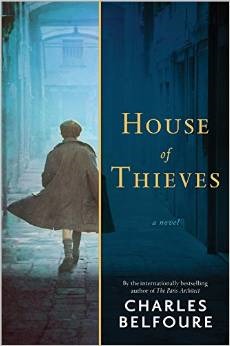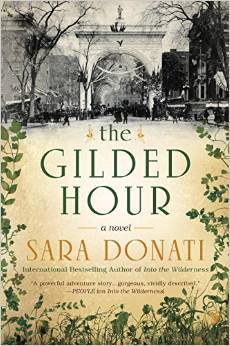This Fall I read two new books with the exact same setting-- The Gilded Age in New York City [1870-1900]. However, beyond the shared frame, these books have very little else in common in terms of traditional appeal factors.
I am grouping them together here because for some people, frame is very important. They will read anything with a specific frame. So as not to repeat myself, I have a much longer piece on that issue here. For those people, I am making sure to put the frame in my "three words" for both books.
Now for others, frame is the not an important issue. Instead pacing or storyline or character etc... is what makes a great read for them. However, we may be tempted to match books when their frame is as similar as these two’s happen to be. You see “Gilded Age” listed for both and you might be tempted to think the books are readalikes for one and other, yet that may not be the case at all.
In fact, if you search either of these books on NoveList, the other appears in the readalike bar on the right. Interestingly, they are computer, not people, created matches based on the shared genre, time period, and place. I do not disagree with this, as I said above, these three frames may be all someone needs to enjoy both books, but this reinforces what I am trying to do here-- suss out the nuances that matter. Because while I liked both, I clearly enjoyed one more than the other AND I have not suggested both to the same reader yet.
To that end these reviews are meant to illustrate the give and take inherent in this issue. Both are very well executed novels that will appeal to a wide range of readers, but at their core’s these novels have a very different feel.
First up, the historical thriller, House of Thieves by Charles Belfoure.
At it’s essence this is the story of how a good, solid man turns to a life of crime, while still staying likable and good in our eyes.
Here is a tiny bit of set up. It’s 1886 and the rich are VERY rich and the poor, very poor. NYC is run by respected crime bosses. They are criminals yes, but they also among the city's largest arts and political donors. They truly run the city. Our villain is Kent, a crime boss and his crew. Our “hero,” John Cross, is an architect for the very rich. But his son has a gambling problem. To resolve the large debt, Kent wants Cross to use his connections and knowledge to help him rob the homes of NYC’s richest residents.
But why you will like this book is how Belfoure writes it. What is so great here is how he managed to write a novel convincingly and accurately set in its historical time, while telling the story in a way today’s audiences like. He nailed both the historical and the thriller aspects.
For historical fiction fans, the novel has all the details of the time and place. It has a lot of information about being an architect to the rich at this time. And it has amazing descriptions of some spectacular homes. The streets, people, and places come alive.
And while I love historical details, sometimes, historical thrillers move to slow for me. I don’t know why I don’t mind it with regular historicals and do with thrillers, but I do and from our discussions in the crime fiction genre study and from my work with readers, I know I am not alone there [*cough cough* The Alienist]. But Belfoure has managed to use modern techniques like short chapters, fluid point of view shifts, and powerful action scenes to ratchet up the suspense and pacing.
Here are two examples that occur in the first 30 pages to illustrate what I am talking about.
First, the novel opens with an awesome bank robbery and explosion scene that then moves to the perspective of the crime bosses who are watching the scene unfold. The details set the historic tone, but the scene served the same purpose that today’s prologues in suspense novels do. We were thrown right into the middle of the story and are excited to keep reading to see what is going on and how our story will fit into this world.
And second [one of my favorite moments in the beginning of a book in a long time], at around page 30, we see the beginning of the day in a rich home. One of the things the wealthy of this time had were ice boxes. They were built into the side of the house with a door that opened to the outside so literal huge blocks of ice could be delivered to keep things in the ice box cold. Well, what if you opened your ice box to find...A FROZEN SEVERED HEAD! That was pretty great. Let’s you know this is not your typical historical thriller.
This novel is under 400 pages and has a moderate cast of characters who all get frequent turns to narrate with fluid and fast paced shifts in the point of view [the entire Cross clan, even the little 10 year old brother has a chance to narrate-- and that was good], yet it is moments like the two above throughout the story that keep the pacing high.
There is also social commentary and flashy fun here [a climax is at the top of the under construction Statue of Liberty!]. But what I loved the most was the ending. The decision Cross and his wife make about how they will live the rest of their lives after the ordeal under Kent’s thumb is over is what takes this book from good to awesome.
Three Words That Describe This Book: flashy fun, suspenseful, Gilded Age
Readalikes: I thought about Pete Hamil and his novel North River while reading this. You can go to my review of North River, which also has readalikes [fiction and nonfiction]. The time period is different though (1934).
I also think the historical thrillers of Matthew Pearl are a good option here. Both authors write compelling, historical thrillers with a solid amount of detail. With Pearl the professional setting is usually book based. I have read a few of them.
But the nuanced characters and their surprising decisions reminded me more of the suspense novels of today. Belfoure has much in common [protagonist wise] with Gillian Flynn or Tana French. I think House of Thieves is a great option for fans of those popular, literary, psychological suspense writer who want a bit more action and don’t mind the historical setting.
Next up is the medical framed, women’s lives, historical by Sara Donati, The Gilded Hour.
Here the date is 1883 and again we are in NYC. The story is about the forgotten people of this time. It is about racial injustice, the suppression of women, medical advancements, and fertility issues.
Our main characters are two women, cousins, one who is half black, who are trying to provide birth control to women and how they were prosecuted by a real life Postal Inspector (who had a ton of political and legal power) and his crusade to suppress vice [The Comstock Act].
Okay first big difference here, the pacing. This is a 700 page, traditional historical. It moves at a much more methodical pace but one that is appropriate to the type of book; it is a pace that fans of a thick historical will expect and enjoy.
You know it will be a complex, historical because the families and major characters are listed in the front two pages and those who are real are noted. The novel also incorporates newspaper articles, telegraphs, and letters as a narrative device to keep up an authentic tone, as opposed to House of Thieves above, where things get a bit outrageous [but super fun] at times. Again, same setting but two different readers.
This is a great read for people interested in the history of medicine, women's history [especially women in medicine], women's lives, and/or a history of women's health issues. There is a strong romance element here too.
There is suspense with the postal inspector trying to catch our heroes. There are many people [of all sexes and races] who help them along the way. Things get tense and threatening but the overall story is not about the crime angle, it is more the issues I listed in the previous paragraph.
Three Words That Describe This Books: history of medicine, character centered, Gilded Age
Readalikes: The most obvious readalike is a TV series-- The Knick-- which I have written about at length with readalikes here.
Donati also mentioned the wonderful Destiny of the Republic by Candice Millard which I read here, for people who want more history of medicine detail from this era. I agree.
Another author who is similar to Donati is Jennifer Donnelly. Both write historicals featuring women and their lives with strong romance elemnts. Interestingly, Donnelly has a very similar historical novel about social conscious female doctors, The Winter Rose.
Finally, a book I read which had a very similar feel, although is set in Brooklyn in 1700s and follows a woman who runs a gin still is Brookland by Emily Barton. I highly suggest this for fans of a book like The Gilded Hour. You can click on the title for my full review.
#HorrorForLibraries: 3 Fall ARCs from Flame Tree Press
-
Today I have two finished copies for two winners of a volume featuring many
authors whose work you have on your sleeves, presented by a trusted editor,
a...
18 hours ago











No comments:
Post a Comment